How do you squeeze more trail performance into an XC rig? With its pimped-up spec and jacked-up fork, the MERIDA NINETY-SIX 8000 wants to step up its downhill performance. But did the € 7,049 MERIDA with its striking colour concept deliver on the trail and did it smoke the entire test field uphill?
For an overview of the test fleet head to the group test: The best mountainbike of 2021 – 22 models in review

11.66 kg (size L) | € 7,049 | Manufacturer-website
Straight away, the MERIDA NINETY-SIX 8000 stands out from the crowd. Its silhouette with a super-low front and high seat tube is strongly reminiscent of an XC racer. The elegant colour scheme is consistent throughout and perfectly matches the 120 mm RockShox SID Ultimate fork – a killer look! The RockShox SIDLuxe Ultimate shock drives 100 mm travel. Like the Specialized Stumpjumper, the NINETY-SIX dispenses with the additional pivot between the seat and chainstays, relying on flexstays instead to save weight. Our top-spec MERIDA NINETY-SIX 8000 in size L tips the scales at 11.66 kg. The cables and brake lines are cleverly routed through the top cap and run straight into the frame. Unfortunately, clever isn’t always synonymous with tidy: in fact, the cockpit area still looks crammed, with the front brake line and lockout remote cables dangling off the bars like high-voltage power lines. In this regard, bikes like the Specialized Stumpjumper offer much tidier solutions. The frame has enough room for two large water bottles and features a mount on the top tube, which can be used to store two CO2 cartridges and a spare tube using the optional adapter. The position of the brake levers is unfortunate: if the bars turn all the way in during a crash, they’ll hit the carbon frame and damage the paint – not good! Here it would make sense to use a steering stop system like the one you get with the Trek Top Fuel and Canyon Neuron.


Brave – The spec of the MERIDA NINETY-SIX 8000
As far as its spec goes, the € 7,049 MERIDA NINETY-SIX 8000 has a few surprises in store. For example, it’s the only bike in this test that comes equipped with a RockShox SID Ultimate fork which, like its competitor, the FOX 34 Step-Cast in the Trek Top Fuel, offers 120 mm of travel. To save weight, RockShox forgo an external rebound dial on the SID fork and replace this with an integrated Allen key, which can be removed and used to adjust the rebound setting, both on the fork and SIDLuxe shock. The lockout on both suspension units is actuated via a SRAM TwistLoc grip on the handlebars. Unlike the lockout systems of the SCOTT Ransom and Trek Top Fuel, the TwistLoc of the MERIDA is simple and easy to operate, avoiding mistakes on the trail. Compared to the Yeti SB115 and Trek Top Fuel with their wide handlebars, the cockpit of the Merida with its super narrow 740 mm XC bars doesn’t inspire confidence. For the dropper post, MERIDA rely on their own 170 mm Expert TR model
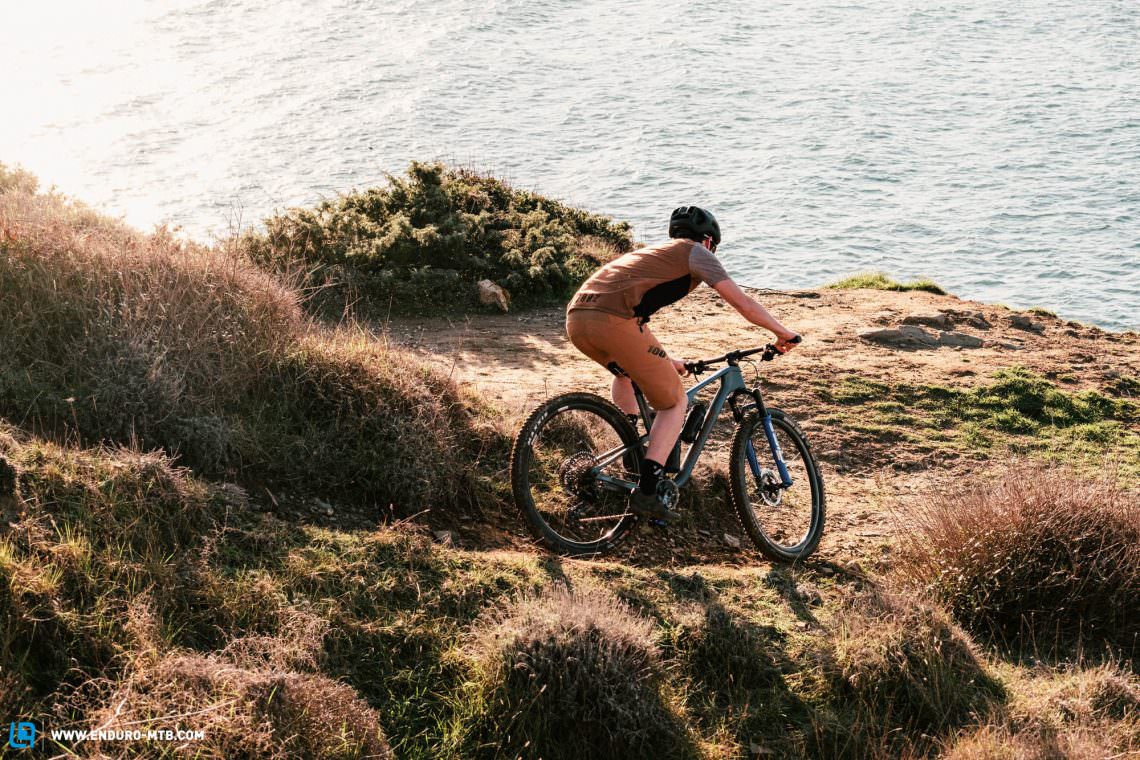
Braking is taken care of by Shimano XT brakes, with a four-piston calliper at the front and two-piston version at the rear. The brakes are paired with Shimano’s top-end IceTech rotors, with a bigger 180 mm rotor at the front and smaller 160 mm disc out back. The rear calliper is nestled between the seat and chainstays, attached to the frame with a Flat-Mount adapter. While this ensures a very tidy look, it limits the size of the rotor to a maximum of 180 mm. All in all, the brakes don’t provide enough braking power and really struggle with heat management. The NINETY-SIX 8000 comes equipped with a 12-speed Shimano XT drivetrain with a small chain guide. A unique feature for a bike with such strong XC DNA is the burly MAXXIS Minion DHRII tires with EXO casings and MaxxTerra compound front and rear. This is evidence that the MERIDA is built for fun and safety and not, like its direct competitor, the Trek Top Fuel, fast-paced KOM hunting uphill. Reynolds supply the Carbon TR 309 S wheelset. If you’re a heavy rider, we recommend running high air pressures to avoid pinch flats and nasty surprises – especially at the rear.

In purely visual terms, the MERIDA NINETY-SIX 8000 is a stunner. The elegant shade of blue runs across the entire bike and is complemented by the matching RockShox SID fork.
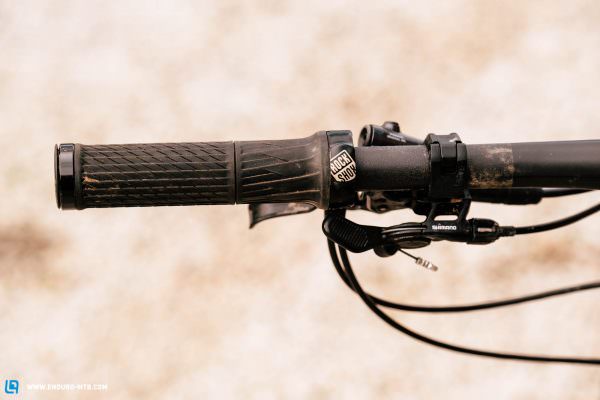
Yeah, we know it’s on the wrong side but if you turn it, you’ll still be flying off. The TwistLoc is easy and intuitive to operate and avoids confusion on the trail – awesome!
MERIDA NINETY-SIX 8000
€ 7,049
Specifications
Fork RockShox SID Ultimate 120 mm
Rear Shock RockShox SIDLuxe Ultimate 100 mm
Seatpost MERIDA Expert TR 170 mm
Brakes Shimano XT M8120/FM 180/160 mm
Drivetrain Shimano XT 1x12
Stem MERIDA Team CC 60 mm
Handlebar MERIDA Team CC 740 mm
Wheelset Reynolds Carbon TR 309 S 29"
Tires MAXXIS Minion DHRII EXO 3C MaxxTerra/DHRII EXO 3C MaxxTerra 2.3
Technical Data
Size S M L XL
Weight 11.66 kg
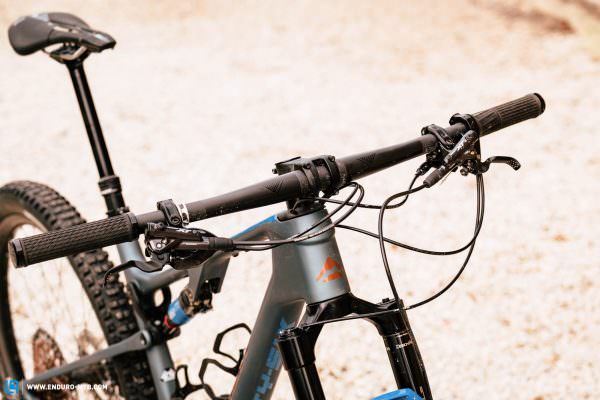
The many cables for the brakes, dropper and TwistLoc cluttered the cockpit. If you’re not extra careful or in the event of a crash, the brake levers could easily damage the top tube – thumbs down!
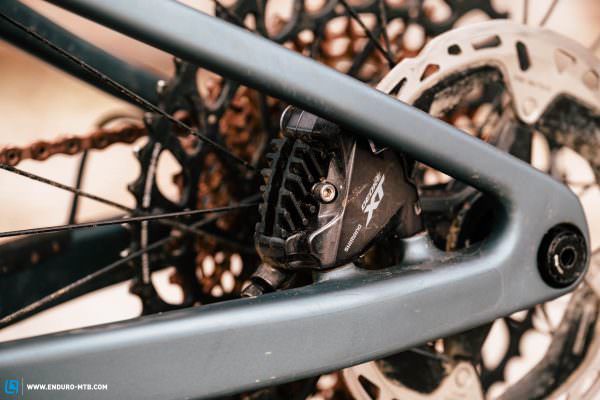
The small two-piston Shimano XT brake is positioned between the seat and chainstays but delivers too little braking power.
Race feeling – The geometry of the MERIDA NINETY-SIX 8000 in detail
It’s impossible for the MERIDA NINETY-SIX 8000 to hide its XC roots – the geometry alone gives it away! Available in four sizes, S to XL, it has a 605 mm stack height in size L and the lowest front in the entire test field. Combined with the 460 mm reach and a very high 470 mm seat tube, this restricts the freedom of movement on the bike. If you want to choose the frame based on your desired reach, be warned: the next size up has a rather massive 500 mm seat tube. With the dropper fully extended, the impressive saddle to bar drop puts you in an extremely sporty position. While this isn’t exactly comfortable and thus not suitable for long rides, it really helps keep the front wheel planted on steep ramps
Twisted world – the limiting factor of the MERIDA NINETY-SIX 8000 is its uphill performance.
| Size | S | M | L | XL |
|---|---|---|---|---|
| Seat tube | 400 mm | 440 mm | 470 mm | 500 mm |
| Top tube | 581 mm | 601 mm | 624 mm | 648 mm |
| Head tube | 95 mm | 95 mm | 105 mm | 115 mm |
| Head angle | 67.0° | 67.0° | 67.0° | 67.0° |
| Seat angle | 75.0° | 75.0° | 75.0° | 74.5° |
| Chainstays | 435 mm | 435 mm | 435 mm | 435 mm |
| BB Drop | 36 mm | 36 mm | 36 mm | 36 mm |
| Wheelbase | 1,136 mm | 1,156 mm | 1,180 mm | 1,203 mm |
| Reach | 420 mm | 440 mm | 460 mm | 480 mm |
| Stack | 595 mm | 595 mm | 605 mm | 614 mm |
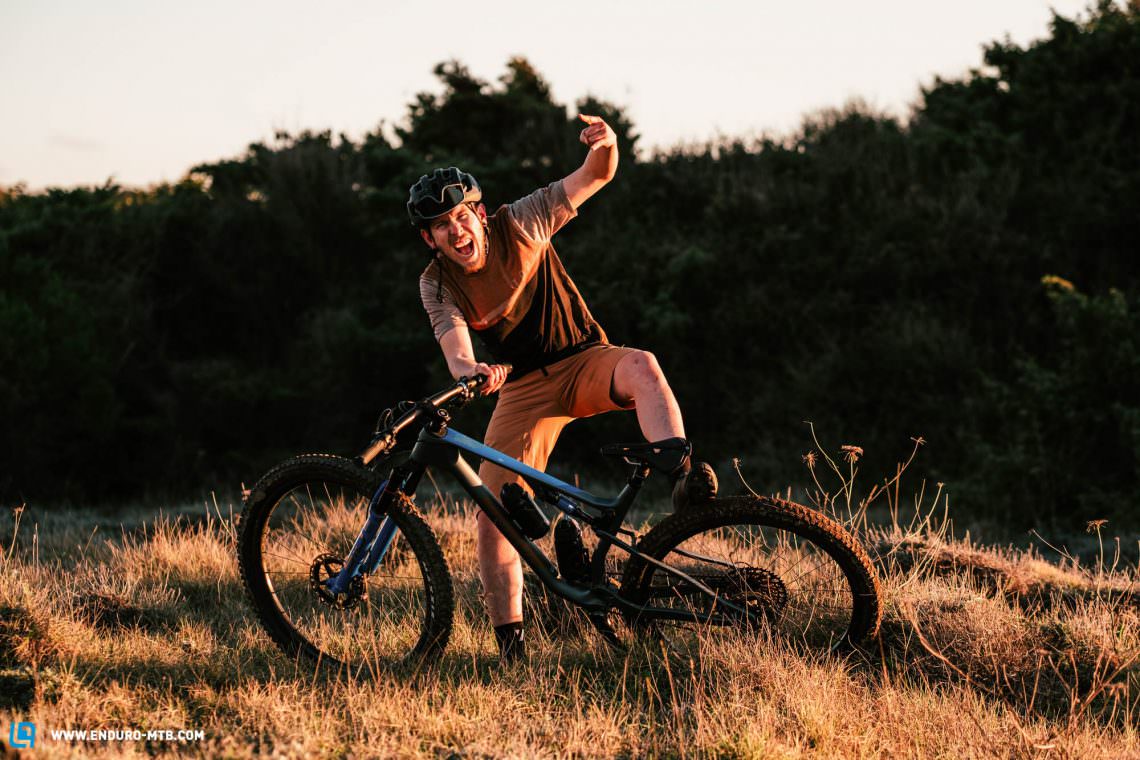
Shorts 100% Airmatic Short | Shoes Giro Sector
A very special case – The MERIDA NINETY-SIX 8000 on the trail
If you assume that the XC-infused DNA of the MERIDA NINETY-SIX makes it a strong climber, you’re wrong. The slack 75° seat angle shifts your weight far back over the rear wheel and causes the rear end to sink into its travel, even on flat forest paths. Here, only the climb switch helps: this makes the suspension super stiff, helps transfer the power into the ground more efficiently on flat terrain and thus ensures great acceleration. However, if you decide to get to the trailhead on a technical trail, the stiff rear end results in a bumpy ride and tends to get stuck on obstacles, causing the rider to lose momentum in key trail sections. Here the MERIDA clearly falls behind its direct rivals, the Trek Top Fuel and Yeti SB115.
With an active riding style and an experienced rider, the MERIDA can be real fun. That said, the bike doesn’t inspire much confidence.

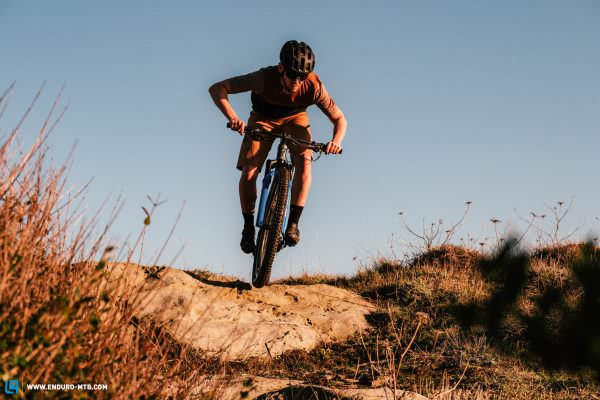
Tuning-tips: bigger brake rotor at the rear | wider and higher cockpit
Downhill, the MERIDA NINETY-SIX 8000 requires an experienced rider and a clean riding technique. The geometry and flat handlebars pull you far over the front. While this ensures super direct handling, it also triggers unnerving OTB moments on steep trail sections. On flat trails, the grippy tires implement steering inputs willingly and thus enable an active riding style. While using burly tires on an XC rig might seem a bold move, it’s a clever one too. With the right rider, the MERIDA can even pull past the Top Fuel on fast descents – and is more fun in the process. However, on faster trails with larger obstacles and small jumps, the NINETY-SIX 8000 gets overwhelmed and fails to inspire the confidence you need if you want to have fun and feel safe in the process. Here, the Yeti SB115 is clearly ahead with its downhill-oriented cockpit and at the same time offers more reserves with its superior suspension. The MERIDA NINETY-SIX is mainly suitable for short, fast laps on simple singletracks.
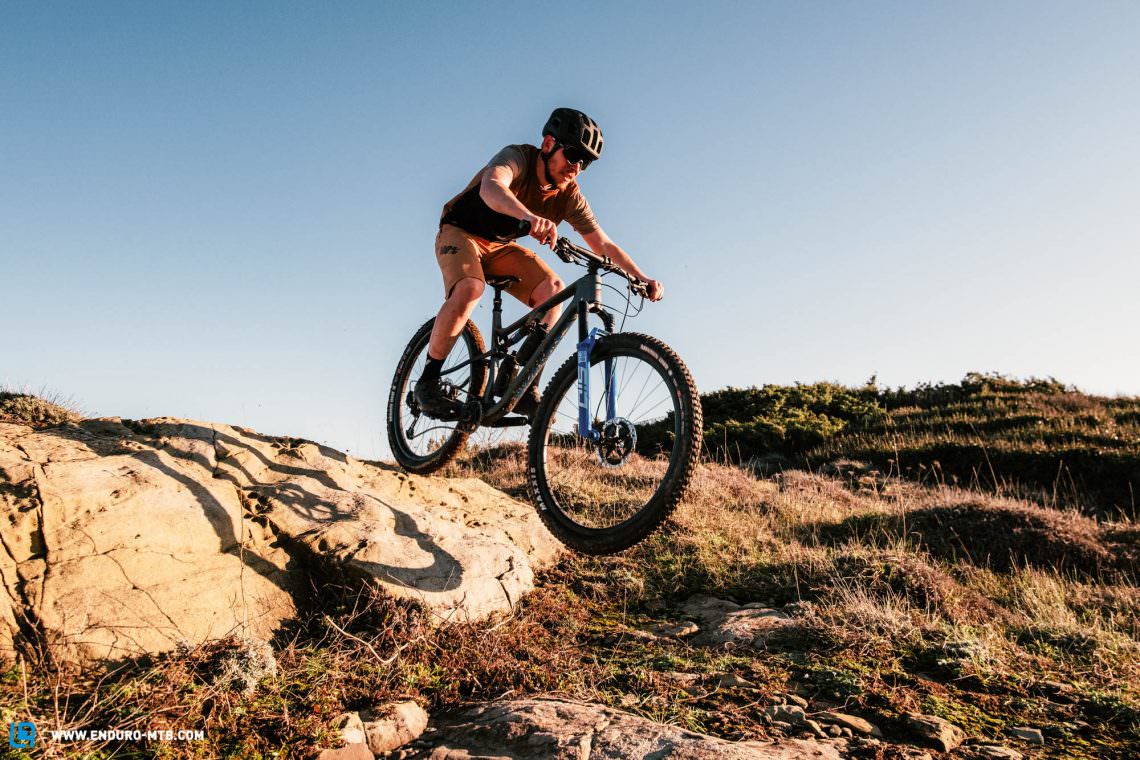
Conclusion
The overall concept of the MERIDA NINETY-SIX 8000 wants to boost the trail capabilities of an XC racer with a pimped-up spec. Unfortunately, it doesn’t work. Surprisingly enough, the limiting factor is its uphill performance. The suspension bobs heavily and the pedalling position is unsuitable for longer rides. Unfortunately, all of the above puts the MERIDA right at the bottom of our test field on the climbs. Downhill, only skilled riders will be able to ride fast and have fun while feeling safe in the process. On the other hand, if you’re a newbie the NINETY-SIX inspires too little confidence and doesn’t provide enough reserves.
Tops
- consistent colour and design concept
- 2 bottle cages and a tool mount on the frame
Flops
- the overall concept doesn't work due to the poor uphill performance
- demanding uphill and downhill
- two-piston rear calliper overheats quickly and gets overwhelmed
Find more information here: merida-bikes.com
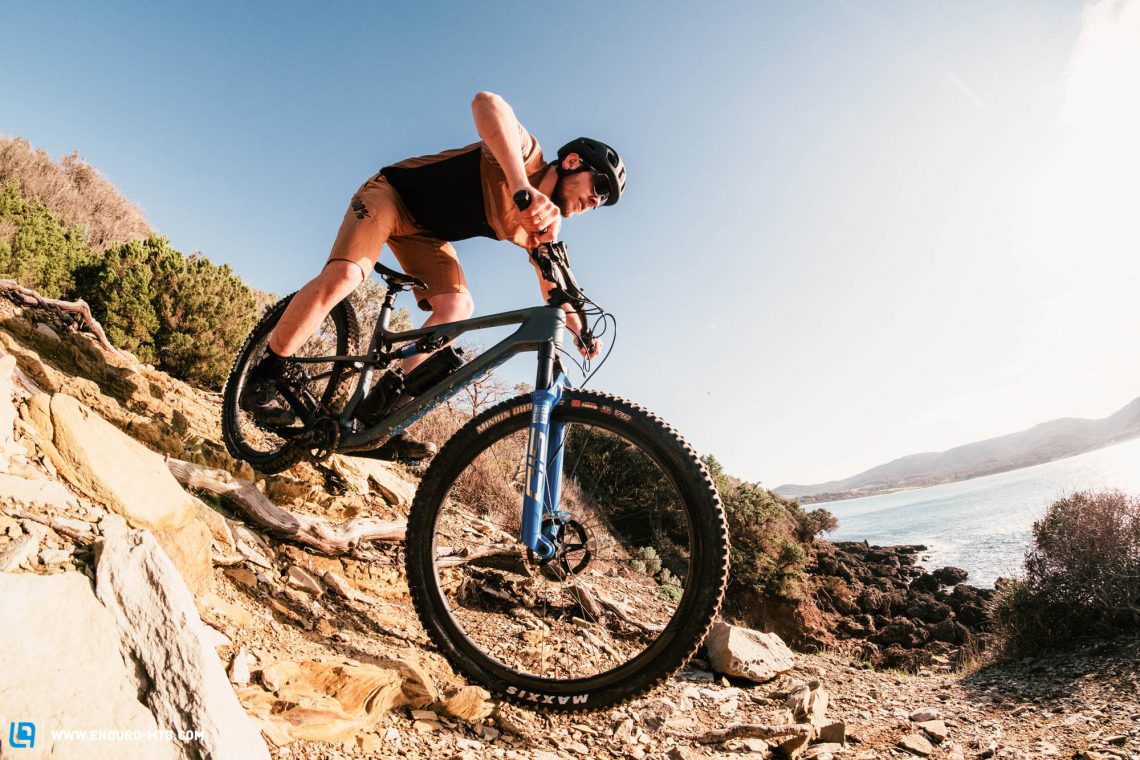
The testfield
Get an overview of the grouptest here: The best mountainbike of 2021 – 22 models in review
All Bikes in this group test: Canyon Neuron CF SLX 9 (Click for review) | Canyon Spectral 29 LTD (Click for review) | Canyon Stoic 4 (Click for review) | FOCUS THRON 6.9 (Click for review) | Ibis Ripmo V2 (Click for review) | MERIDA eONE-SIXTY 10K (Click for review) | MERIDA NINETY-SIX 8000 | Nukeproof Reactor 290C (Click for review) | Orbea Rise M-Team (Click for review) | Propain Hugene (Click for review) | RAAW Jibb XTR Build (Click for review) | Rocky Mountain Instinct C70 (Click for review) | Santa Cruz 5010 X01 (Click for review) | Santa Cruz Tallboy CC X01 (Click for review) | SCOTT Ransom 900 Tuned AXS (Click for review) | Specialized S-Works Stumpjumper (Click for review) | Specialized S-Works Stumpjumper EVO (Click for review) | Specialized S-Works Turbo Levo SL (Click for review) | Trek Fuel EX 9.8 GX (Click for review) | Trek Top Fuel 9.9 X01 (Click for review) | Yeti SB115 TURQ3 (Click for review) | YT IZZO BLAZE 29 (Click for review)

Did you enjoy this article? If so, we would be stoked if you decide to support us with a monthly contribution. By becoming a supporter of ENDURO, you will help secure a sustainable future for high-quality mountain bike journalism. Click here to learn more.
Words: Peter Walker Photos: various









